LESSON ASSIGNMENT Paragraphs 5-1 through 5-10.
LESSON OBJECTIVES After completing this lesson, you should be able to:
5-1. Identify the procedures for immobilizing a fractured arm using a wire ladder splint.
5-2. Identify the procedures for immobilizing a fractured upper arm or forearm using a SAM splint.
5-3. Identify the procedures for immobilizing a fractured upper arm, elbow, or forearm using an improvised splint.
5-4. Identify the procedures for immobilizing an arm using a sling and swathes.
5-5. Identify the procedures for immobilizing a dislocated shoulder.
5-6. Identify the procedures for applying a pneumatic splint.
SUGGESTION After completing the assignment, complete the exercises at the end of this lesson. These exercises will help you to achieve the lesson objectives.
5-1. IMMOBILIZE AN ARM WITH A WIRE LADDER SPLINT
A wire ladder splint can be used to immobilize a fracture of the forearm, a fracture of the humerus, a fracture of the elbow when the elbow is bent, or an arm with multiple fractures.
a. Prepare Wire Ladder Splint.
(1) Bend the prong ends of the splint away from the smooth side. About 1.5 inches should be bent.
(2) Place the smooth side of the splint against the casualty’s uninjured arm with the bent end even with the top of the uninjured shoulder.
(3) Select a point slightly below the casualty’s uninjured elbow.
(4) Remove the splint from the casualty’s arm and bend the splint into an “L” shape at the selected point. The smooth side of the splint should be on the inside of the “L” and the bent prong should be on the outside.
(5) Pad the splint by wrapping a roller bandage around it (see figure 5-1) or by applying leaves, material, or other padding on the inside of the splint. If padding materials are not available, apply the splint without padding.
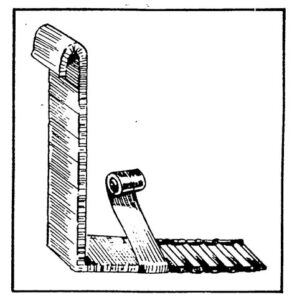
b. Apply the Wire Ladder Splint.
(1) Position the splint on the outside of the casualty’s injured arm with the bent prongs away from the shoulder.
(2) The angle of the splint should extend beyond the elbow and not touch the elbow. The splint should not place pressure on the elbow. The upper arm, forearm, and hand will have contact with the splint.
(3) Check the distal end of the splint. If the splint does not extend beyond the ends of the casualty’s fingers, use a basswood splint or other device to lengthen the splint.
(4) If possible, have the inside of the casualty’s hand and forearm toward his chest.
(5) If possible, have the casualty support the splint and injured arm.
c. Apply Wad to Hand. Place a rolled cravat or similar material in the palm of the casualty’s injured hand (see figure 5-2).
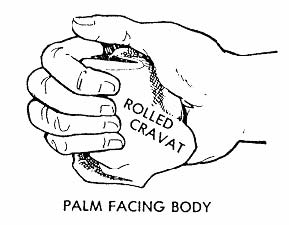
d. Check Pulse. Check the casualty’s pulse below the fracture site. If no pulse is found, evacuate the casualty as soon as possible after the upper arm is splinted.
(1) If there is no pulse, one attempt should be made to pull traction on the arm to restore the pulse.
(2) If the casualty has extreme pain or resistance is felt, the attempt should be stopped and the limb splinted in place.
e. Secure the Wire Ladder Splint.
(1) Apply five cravats to the wire ladder splint (see figure 5-3).
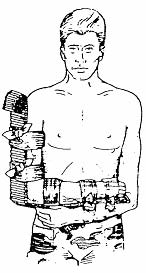
(a) Apply two cravats to the upper arm. If the humerus is fractured, apply one cravat above the fracture site and one cravat below the fracture site. Do not apply a cravat over the fracture site.
(b) Apply two cravats to the forearm. If the forearm is fractured, apply one cravat above the fracture site and one cravat below the fracture site. Do not apply a cravat over the fracture site.
(c) Apply one cravat around the hand and splint in an “X” pattern.
(2) Tie the tails of the cravats in a non-slip knot on the outside of the splint. Tuck the ends of the tails into the cravat.
(3) Check the casualty’s pulse after each cravat is applied. If the pulse can no longer be detected, loosen the cravat and apply it again. If this does not restore circulation, evacuate the casualty as soon as possible.
f. Apply Sling and Swathes. Apply a sling and swathes to further immobilize the casualty’s arm. Slings and swathes are discussed in paragraphs 5-8 and 5-9.
(1) If the humerus is fractured, apply two swathes–one above the fracture site and one below the fracture site.
(2) If the humerus is not fractured, make the swathe wide across the injured arm.
5-2. IMMOBILIZE A FRACTURED FOREARM WITH A SAM SPLINT
a. Unroll the SAM splint and flatten it.
b. Fold the SAM splint in half so it is a tall “V” shape.
c. Bend the edges of the splint in until the shape of the splint generally conforms to the curve and shape of the limb being splinted (see figure 5-4A). Each half of the splint will have a “U” shape.
d. Check the casualty’s pulse below the fracture site. If no pulse is found, evacuate the casualty as soon as possible after the forearm is splinted.
e. Apply the SAM splint to the forearm. The elbow should rest in the bottom of the “V” and the sides of the “V” are on the inside and outside of the forearm.
f. Adjust the shape of the SAM splint to conform to the limb, if needed.
g. Secure the splint using at least two cravats (see figure 5-4B).
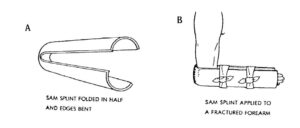
(1) Apply at least one cravat above the fracture site and at least one cravat below the fracture site. If possible, apply two cravats above the fracture site and two cravats below the fracture site. Do not apply a cravat over the fracture site.
(2) Tie the tails of the cravats in a non-slip knot on the outside of the splint. Tuck the ends of the tails into the cravat to prevent accidental entanglement when the casualty is moved.
(3) Check the casualty’s pulse after each cravat is applied. If the pulse can no longer be detected, loosen the cravat and apply it again. If this does not restore circulation, evacuate the casualty as soon as possible.
(4) If cravats are not available, use tape or a roller bandage to secure the SAM splint.
h. Position the casualty’s forearm so it is across his chest with the wrist slightly higher than the elbow.
i. Apply a sling and a swathe to further immobilize the casualty’s arm. Make the swathe wide across the injured arm.
5-3. IMMOBILIZE A FRACTURED HUMERUS WITH A SAM SPLINT
a. Unroll the SAM splint and flatten it.
b. Fold the SAM splint into an irregular (uneven) “V” shape with one side of the V about four to six inches longer than the other.
c. Bend the edges of the splint so the sides of the splint are U-shaped and generally conform to the shape of the limb being splinted.
d. Check the casualty’s pulse below the fracture site. If no pulse is found, evacuate the casualty as soon as possible after the upper arm is splinted.
e. Position the casualty’s forearm so it is across his chest with the wrist slightly higher than the elbow.
f. Apply the SAM splint to the upper arm. The upper part of the forearm (where it joins the elbow) should rest in the bottom of the “V,” the short side of the “V” is on the inside of the upper arm (but not pressing on the arm pit), and the long side is on the outside of the upper arm with the end extending to or past the shoulder.
g. Adjust the shape of the SAM splint to conform to the limb, if needed.
h. Secure the splint using at least two cravats (see figure 5-5).
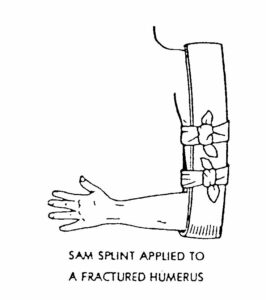
(1) Apply at least one cravat above the fracture site and at least one cravat below the fracture site. If possible, apply two cravats above the fracture site and two cravats below the fracture site. Do not apply a cravat over the fracture site.
(2) Tie the tails of the cravats in a non-slip knot on the outside of the splint. Tuck the ends of the tails into the cravat to prevent accidental entanglement when the casualty is moved.
(3) Check the casualty’s pulse after each cravat is applied. If the pulse can no longer be detected, loosen the cravat and apply it again. If this does not restore circulation, evacuate the casualty as soon as possible.
(4) If cravats are not available, use tape or a roller bandage to secure the SAM splint.
i. Apply a sling and a swathe to further immobilize the casualty’s arm. If possible, apply two swathes–one above the fracture site and one below the fracture site.
5-4. IMMOBILIZE A FRACTURED HUMERUS WITH AN IMPROVISED SPLINT
Wire ladder splints, SAM splints, and pneumatic splints are used to immobilize a fracture of the upper extremity. If these splints are not available, a splint can be made from improvised rigid objects and securing materials. Basswood boards, tree limbs, broken poles, boards, or rolled newspaper can be used as rigid objects. If a rigid object cannot be readily found, the casualty’s chest can be used as the rigid object. Cravats, slings, and swathes are normally made from triangular bandages (paragraph 2-4c). If muslin bandages or other materials are not available to make triangular bandages, strips of torn cloth, belts, or similar objects can be used. Wire, shoestrings, and other very narrow materials should not be used. General procedures for applying an improvised splint to a fractured humerus are given in the following paragraphs.
a. Gather two rigid objects, securing materials, and padding.
b. Pad the rigid objects.
c. Check the casualty’s pulse below the fracture site. If no pulse is found, evacuate the casualty as soon as possible after the splint is applied.
d. Place the rigid objects on each side of the upper arm. Make sure the inside rigid object is not pressing on the axilla (armpit).
e. Secure the rigid objects with cravats or other securing material.
(1) Apply at least one cravat above the fracture site and at least one cravat below the fracture site. If possible, apply two cravats above the fracture site and two cravats below the fracture site. Do not apply a cravat over the fracture site.
(2) Tie the tails of the cravats in a non-slip knot on the outer rigid object and tuck in the tails.
(3) Check the casualty’s pulse after each cravat is applied. If the pulse can no longer be detected, loosen the cravat and apply it again. If this does not restore circulation, evacuate the casualty as soon as possible.
f. Apply a sling and a swathe to further immobilize the casualty’s arm. If possible, apply two swathes–one above the fracture site and one below the fracture site.
5-5. IMMOBILIZE A FRACTURED ELBOW WITH AN IMPROVISED SPLINT
Immobilize the upper arm and forearm in the position you find them. If the elbow is bent, leave it bent. If the elbow is not bent (arm straight), do not try to bend it in order to apply a sling to the arm.
a. Elbow in Bent Position.
(1) Check the casualty’s pulse below the fracture site. If no pulse is found, evacuate the casualty as soon as possible after the splint is applied.
(2) Apply a rigid object (padded, if possible) to the inside of the casualty’s limb so it can immobilize the elbow.
(3) Secure the rigid object with at least two cravats (see figure 5-6 A).
(a) Apply at least one cravat above the fracture site (secure the upper arm to the rigid object) and at least one cravat below the fracture site (secure the forearm to the rigid object). Do not apply a cravat over the elbow.
(b) Tie the tails of the cravats in a non-slip knot on the rigid object and tuck in the tails.
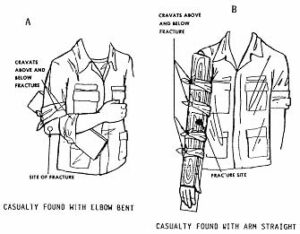
(c) Check the casualty’s pulse after each cravat is applied. If the pulse can no longer be detected, loosen the cravat and apply it again. If this does not restore circulation, evacuate the casualty as soon as possible.
(4) Apply a sling and swathe to help support the arm, but do not place the elbow and rigid object inside the sling.
b. Elbow Not Bent.
(1) Check the casualty’s pulse below the fracture site. If no pulse is found, evacuate the casualty as soon as possible after the splint is applied.
(2) Apply two rigid objects (padded, if possible) to the casualty’s limb. The rigid objects should be long enough to immobilize the elbow and the wrist. The bottom rigid object should extend beyond the fingers of the injured hand. Make sure the inner splint does not press on the axilla.
(3) Place a rolled cravat or similar material in the palm of the casualty’s injured hand.
(4) Secure the rigid object with at least four cravats (see figure 5-6 B).
(a) Apply at least two cravats above the fracture site and two cravats below the fracture site. Do not apply a cravat over the elbow.
(b) Tie the tails of the cravats in a non-slip knot on the outer rigid object and tuck in the tails.
(c) Check the casualty’s pulse after each cravat is applied. If the pulse can no longer be detected, loosen the cravat and apply it again. If this does not restore circulation, evacuate the casualty as soon as possible.
(5) Apply two swathes, one above the elbow and one below the elbow.
5-6. IMMOBILIZE A FRACTURED FOREARM WITH AN IMPROVISED SPLINT
A fractured forearm can be splinted using one or two rigid objects. Figure 5-7 shows an improvised splint using a single board as the rigid object.
a. Gather one or two rigid objects, securing materials, and padding. The rigid object(s) should extend from the elbow to beyond the fingers.
b. Pad the rigid object(s).
c. Check the casualty’s pulse below the fracture site. If no pulse is found, evacuate the casualty as soon as possible after the splint is applied.
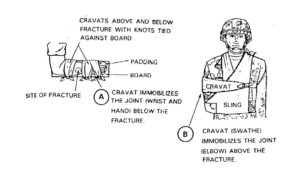
d. Place the padded rigid object under the casualty’s injured forearm so the splint extends from the elbow past the fingers. If two rigid objects are used, place the second padded rigid object on top of the forearm.
e. Place a rolled cravat or similar material in the palm of the casualty’s cupped hand (see figure 5-2) and turn the hand so it will be in a natural position (palm toward casualty’s body).
f. Secure the rigid object(s) with at least three cravats or other securing material.
(1) Apply the first cravat between the fracture site and the elbow.
(2) Apply the second cravat between the fracture site and the wrist.
(3) Apply the third cravat in an “X” fashion over the hand. Leave the fingernails exposed so a blanch test (pressing on nails, then releasing to see how fast color returns to the nail beds) can be performed.
(4) Tie the tails of the cravats in a non-slip knot on the outer part of the rigid object and tuck in the tails.
(5) Check the casualty’s pulse after each cravat is applied. If the pulse can no longer be detected, loosen the cravat and apply it again. If this does not restore circulation, evacuate the casualty as soon as possible.
g. Apply a sling and a swathe to further immobilize the injured arm.
5-7. IMMOBILIZE A DISLOCATED SHOULDER
A dislocation of the shoulder occurs when the head of the humerus is pushed out of its socket at the shoulder. The dislocation can be either anterior (the head pushed forward) or posterior (the head pushed backward). Most dislocations will be anterior dislocations. Shoulder dislocations are painful and the casualty (if conscious) will usually attempt to hold the arm on the injured arm to prevent movement. The shoulder will not have its normal rounded appearance. Immobilize the injured shoulder and upper arm without attempting to reduce the injury (replace the humerus in its socket).
a. Anterior Dislocation. If the head of the humerus is displaced toward the casualty’s front, the arm will be a fixed position away from the casualty’s chest. Do not try to reposition the arm as any attempt to move the arm toward the chest will produce additional pain. Immobilize the arm in the extended position.
(1) Check the casualty’s pulse below the dislocation. If no pulse is found, evacuate the casualty as soon as possible after the arm is immobilized.
(2) Apply padding (a rolled blanket, pillow, or other material) between the upper and the chest to fill the space between them.
(3) Flex the elbow so the casualty’s wrist is slightly higher than the elbow.
(4) Apply a sling (arm sling number two) to support the forearm.
(5) Apply a swathe to further immobilize the arm and to secure the padding materials.
(6) Evacuate the casualty in either a sitting position or laying on a litter.
b. Posterior Dislocation. If the head of the humerus is displaced toward the casualty’s back:
(1) Check the casualty’s pulse below the dislocation. If no pulse is found, evacuate the casualty as soon as possible after the arm is immobilized.
(2) Position the casualty’s forearm across his midsection with his wrist slightly higher than his elbow.
(3) Apply a sling to immobilize the arm. Use the arm sling number two method to protect the shoulder from additional pressure.
(4) Apply a swathe to further immobilize the arm.
(5) Evacuate the casualty, either in sitting position or lying on a litter.
5-8. APPLY A SLING TO AN ARM
A sling is used to support and immobilize the forearm. It also serves to immobilize the elbow and upper arm. A sling is normally made from a triangular bandage (see paragraph 2-4c and figure 5-8 A). A swathe is normally applied to further immobilize the casualty’s injured arm.
NOTE: The shoulder, upper arm, elbow, and forearm on the injured side may be referred to as “injured” whether or not that particular body part is actually injured.
a. Apply a Sling (Arm Sling Number One) to an Arm. This arm sling is used when the shoulder of the injured arm is not injured.
(1) Insert the triangular bandage between the injured arm and the casualty’s chest so the arm is in the center, the apex of the sling is beyond the elbow, and the top corner of the material is over the shoulder of the injured side (see figure 5-8 B).
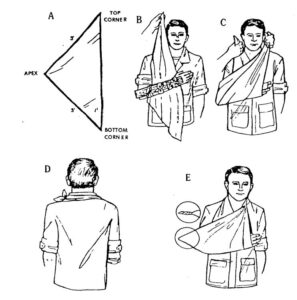
(2) Position the forearm so the hand is slightly higher than the elbow (about a 10 degree angle).
(3) Fold the material along the base (the long side opposite the apex) back to the casualty’s fingers, forming a cuff.
(4) Bring the lower portion of the material over the injured arm so the bottom corner goes over the shoulder of the uninjured side (see figure 5-8 C). The elbow should be inside the sling.
(5) Bring the top corner behind the casualty’s neck.
(6) Tie the two corners together in a non-slip knot at the “hollow” at the neck on the uninjured side (see figure 5-8 D). If the casualty’s right arm is fractured, for example, tie the knot so it will rest in the hollow on the left side of his neck.
(7) Secure the apex of the sling to keep the elbow and forearm from slipping out of the sling.
(a) Safety pin method. Fold the apex forward over the elbow and sling. Pin the apex to the sling.
(b) Pig tailing (twisting) method. Twist the apex of the sling and tuck it in at the elbow (see figure 5-8 E).
b. Apply a Sling (Arm Sling Number Two) to an Arm. This arm sling is used when the shoulder of the injured arm is also injured (dislocated or fractured). Note that the sling goes under, not over, the injured shoulder.
(1) Insert the triangular bandage between the injured arm and the casualty’s chest so the arm is in the center, the apex of the sling is beyond the elbow, and the top corner of the material is over the shoulder of the uninjured side (see figure 5-9 A).
(2) Position the forearm so the hand is slightly higher than the elbow (about a 10-degree angle).
(3) Fold the material along the base (the long side opposite the apex) back to the casualty’s fingers, forming a cuff.
(4) Bring the lower portion of the material over the injured forearm and under the armpit of the injured arm (see figure 5-9 B). The elbow should be inside the sling.
(5) Bring the top corner behind the casualty’s neck.
(6) Tie the two corners together in a non-slip knot on the casualty’s back between his shoulder blades (see figure 5-9 C).
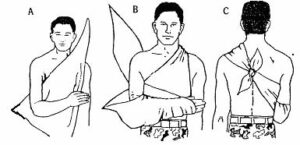
(7) Twist the apex of the sling and tuck it in at the elbow. The corner can also be secured using a safety pin or similar device.
c. Apply a Jacket Flap Sling to an Arm. The flap of a BDU jacket (coat) or a field jacket (coat) can be used as a sling if the time or the materials to make a triangular bandage sling are not available (see figure 5-10).
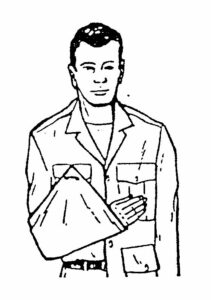
(1) Position the forearm on the casualty’s chest with the hand positioned slightly higher than the elbow.
(2) Undo the jacket so the lower portion (flap) can be brought over the forearm to form a sling.
(3) Bring the flap up over the forearm to the pocket area. Position the elbow so that it is inside the sling and will not slip out of the sling.
(4) Push a stick or other rigid object through the flap and the upper portion of the jacket so the flap will not slip.
5-9. APPLY A SWATHE
\
A swathe is a large strip of cloth, muslin bandage, field dressing, blanket strip, pistol belt, trouser belt, bandoleer, or other material used to immobilize an arm. The swathe should be three to six inches wide.
a. The chest can be used as the rigid object to immobilize an arm (fractured or dislocated shoulder, fractured humerus, or fractured clavicle) by applying a sling to the forearm and swathes to the upper arm. If the humerus is fractured, one swathe is applied above the fracture and one swathe is applied below the fracture (see figure 5-11).
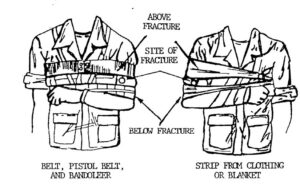
b. Two swathes are applied when immobilizing a fractured elbow (not bent) once the arm has been splinted. One swathe is applied above the elbow and one swathe is applied below the elbow (see figure 5-12).
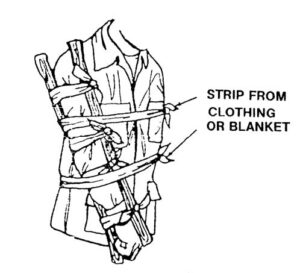
c. A single swathe is normally used to immobilize a fractured forearm once a splint and a sling have been applied (see figure 5-13). The procedures below are for applying a swathe to such an injury, but the same general procedures can be used for applying swathes to other injuries. Applying the swathe over the sling helps to further limit movement of the forearm.

CAUTION: Do not apply a swathe on top of the fracture site. The pressure of the swathe could cause additional damage to the nerves and blood vessels around the broken bone.
(1) Place one end of the swathe on the sling at the breast pocket near the uninjured arm. Hold this end at this location.
(2) Wrap the other end of the swathe across the sling, around the upper arm on the injured side, behind the casualty’s back, under the uninjured arm, and back to the breast pocket.
(a) You have now encircled the casualty’s chest and injured arm. The uninjured arm, however, remains free to move.
(b) Since the fracture is in the forearm and not the upper arm, make the swathe wide (about 12 inches) when it goes across the injured arm. If the casualty had a fractured humerus, you would not make the swathe as wide since the swathe should not be applied on top of a fracture site.
(3) Tie the two ends of the swathe in a non-slip knot over the breast pocket on the uninjured side.
(4) Check the casualty’s pulse below the swathe. If the casualty had a pulse before the swathe was applied but the pulse is no longer present, loosen and retie the swathe. If a pulse is still not present, evacuate the casualty as soon as possible.
5-10. IMMOBILIZE A FOREARM USING A PNEUMATIC SPLINT
A pneumatic (air) is normally used to immobilize a fracture of the forearm or lower leg. A pneumatic splint can be applied quickly and easily. Since they are transparent, the injury can be observed through the splint. Pneumatic splints, however, also have disadvantages. A pneumatic splint cannot be used with an open fracture since the pressure from the splint would force the bone back into the arm. The splint can also be rendered useless if it is torn or punctured. The pressure may need to be adjusted periodically, especially if the casualty is evacuated by air. The procedures below give the general steps for applying a pneumatic splint to a fractured forearm with the casualty lying on the ground.
a. Inspect Splint. Check the splint for cuts, tears, and punctures. Check the air valve and the zipper to make sure they function properly.
b. Check Pulse. Check the casualty’s pulse distal to the suspected fracture. If no pulse is found, evacuate the casualty as soon as possible after the injury is splinted.
c. Apply Splint.
(1) Unzip the splint and lay it flat next to the injured forearm. The splint should be flat (not inflated).
(2) Gently lift the casualty’s forearm. Support the elbow with your hand and cradle his arm in your arm..
(3) With your other hand, move the splint beneath the injured forearm. The splint should be as high on the injured forearm as possible.
(4) Gently lower the forearm onto the splint.
(5) Gently place the splint around the forearm and close the zipper completely.
d. Inflate the Splint.
(1) Open the air valve. This is usually done by turning the valve counterclockwise. A pneumatic (air) splint is normally used to immobilize a fracture of the forearm or lower leg. A pneumatic splint can be applied quickly and easily. Since they are transparent, the injury can be monitored easily.
(2) Inflate the splint by blowing into the air valve.
(a) Always inflate the splint by mouth. Do not use an air pump. It is easy to over inflate a splint when a pump is used. As the air pressure inside the splint increases, so does the pressure caused by the splint on the injured limb. Too much pressure can result in impaired circulation in the limb.
(b) When the splint is properly inflated, you will be able to make a small indentation in the splint by pressing on it with your finger or thumb.
(3) Close the air valve. This is usually done by turning the valve clockwise.
(4) Check the casualty’s pulse distal to the splint. If the casualty had a pulse previously but a pulse can no longer be found, decrease the air pressure in the splint and recheck the pulse. If a pulse still cannot be felt, evacuate the casualty as soon as possible.
e. Monitor the Splint.
(1) Since the splint depends upon air pressure to remain rigid, continue to check the splint to make sure no leaks have developed.
(2) Observe for impaired circulation.
(a) Monitor the casualty’s pulse and the color and temperature of the limb distal to the splint. Also ask the casualty about numbness or tingling sensations if he is responsive. Lower the air pressure if the splint is impairing circulation.
(b) Partially deflate the splint every 20 to 30 minutes to reestablish peripheral circulation in the forearm and hand; then inflate the splint again to its normal rigidity.
(3) Adjust for changes in environment by increasing or decreasing the amount of air in the splint.
(a) Changes in the weather and temperature can affect the air pressure inside the splint.
(b) Decrease the air pressure in the splint if the casualty is to be evacuated by air.
